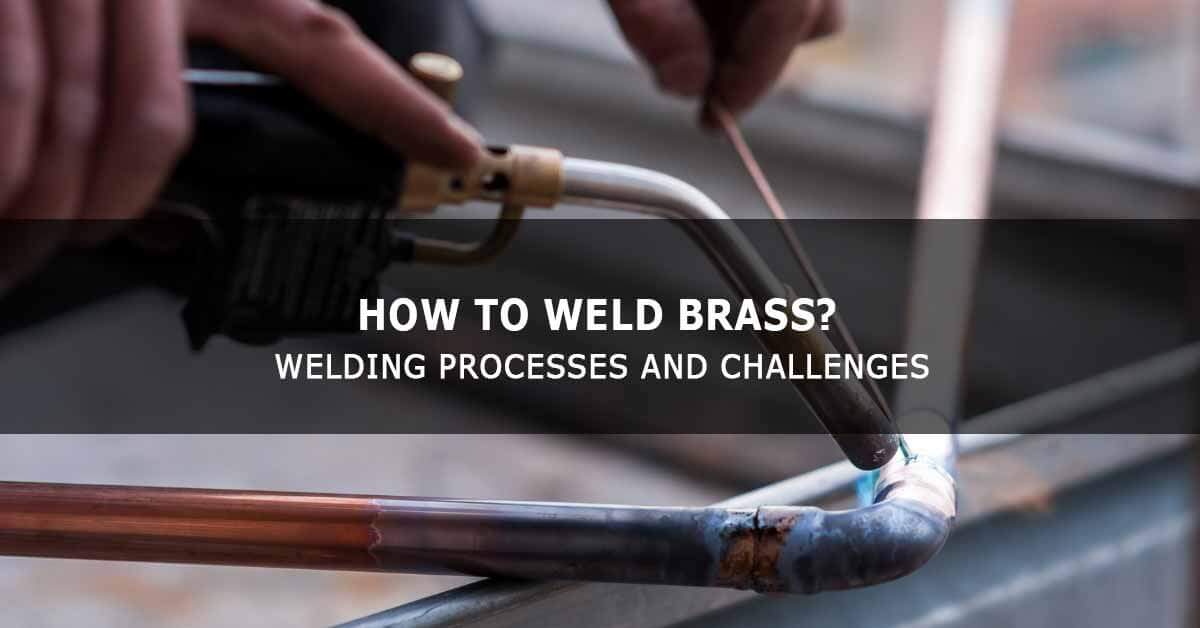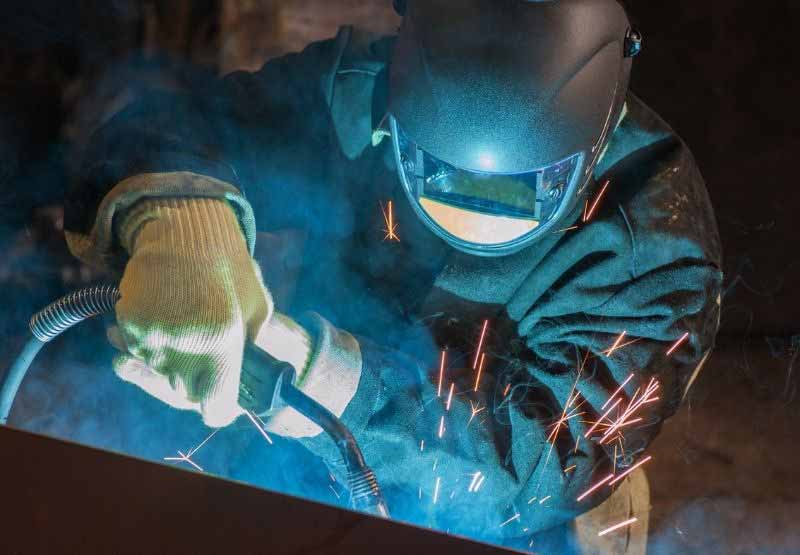Brass is an alloy whose main constituents are copper and zinc and a small percentage of tin, aluminum, lead, etc. The percentage of zinc can be as high as 45% or more. The main issue you face in brass welding is the difference in the melting point of copper and zinc.
This article discusses various issues in brass welding and the welding processes that can be used to weld brass. So, let us start our discussion.
How to weld brass
Brass is an alloy with copper and zinc as its major components, and it can also contain small percentages of tin, aluminum, lead, etc.
The preferred welding processes for welding brass are GTAW/TIG welding, MIG welding, oxyfuel, or oxyacetylene welding can also be used. When doing MIG and TIG welding of brass, selecting the correct shielding gas and filler metal is vital since the weld metal can develop porosity and crack. MMA or stick welding can also be used, but it is not a preferred process.
The filler wire used for MIG/TIG welding brass is generally alloys of copper and silicon (3% silicon) or copper and tin (7% or 12% tin), or copper and aluminum (8% aluminum) and does not contain zinc (not easy to transfer zinc across the arc). Welding electrodes with similar compositions can be used for MMA welding.
The suggested included angle of the weld joint preparation for copper-silicon filler wire is 60º, and it is 70º for copper-tin filler wire metal. Argon should be the shielding gas when TIG/MIG welding thin sections of brass. However, for the thickness of more than 5 mm, a mixture of argon and helium helps provide adequate heat for the welding and uses the pulse welding method.
TIG welding is preferred for welding thin sections (up to 10 mm), and MIG welding is preferred for thicker sections since it has a higher weld metal deposition rate (due to automatic wire feeding).
Select recommended shielding gas and its rate of flow for brass welding and allow the shielding gas to flow for a bit after welding to protect the weld pool until it is cooled.
You must know the composition of the brass (especially its zinc content) before you start welding it since the melting point of zinc is lower than the melting point of copper. Giving more heat than necessary for the welding can produce a weld with porosity and cracks.
Welding thicker sections of brass require preheating (around 100º C /212º F) that can help minimize the loss of zinc by using a low welding current. Preheating is more helpful when welding high zinc alloys.
Thoroughly clean the brass workpiece surfaces to remove oil, dirt, etc. Use a convenient weld work table.
TIG welding brass
Brass is a copper-based alloy and has very high thermal conductivity and the zinc content in brass has a low melting point. When you do TIG welding of brass, many a time the molten zinc can come over the electrode wire and seriously affect the welding process.
Experienced welders suggest using an AC power inverter and 30-second duration pulses and a minimum amount of heat to keep the welding and weld pool on. Also, it is better to interrupt the welding after every few seconds to check the weld pool and to ensure there is no overheating of the work metal.
TIG welding does not produce a good weld bead and it requires a further grinding process to improve the aesthetics. Also, it is advisable to keep the shielding gas flow on for a little more time after the completion of welding. This will allow the weld pool to cool without getting affected by the atmospheric air and pollutants (to avoid weld porosity).
Filler wire with a composition of copper and 7% tin works out good for brass welding and it gives good welding results and acceptable color compatibility.
TIG welding brass is useful for repairing work. DC current (DCEN) and a stabilized arc can also be used for TIG welding brass. Preheating the workpiece (200 º F to 300º F) will help improve the weld. Argon or helium can be used as a shielding gas.
MIG welding brass
The main constituents of brass are copper and zinc. Selecting the correct filler wire for MIG welding brass is essential, and using the wrong filler wire will not create a good weld joint, and the weld’s color will not be compatible with the workpiece.
One of the accepted filler wires for weld color compatibility is a filler wire with copper and 8% aluminum, the weld color may not match precisely with the workpiece color, but it will be of acceptable quality.
If you select a filler wire with zinc content, the zinc will burn out faster (due to its low melting point) and can spoil the welding.
MIG welding of brass follows the standard procedure. Direct current electrode positive (DCEP or reverse polarity) can be used. The preferred shielding gas is pure argon or a mixture of argon and carbon dioxide, and a mixture of 75% argon and 25% carbon dioxide can give you good welding.
You need to ensure a sufficient flow rate of the shielding gas, and failing to do so can result in zinc vapor reacting with the atmospheric oxygen to form zinc oxide. Zinc oxide is toxic, and inhaling it can affect the welder’s health.
Experienced welders suggest doing stitch welding instead of doing one continuous welding. This will allow the molten weld pool more time to cool, minimize exposure to constant heat, and regulate the weld heat input.
Flame or gas welding of brass
If you want a weld color compatible with the workpiece metal, oxy-fuel or oxyacetylene flame welding is a preferred process. For best color compatibility, you can use a filler wire with copper, zinc, and tin composition. This process is suitable for welding brass to brass.
It would be best if you use a recommended flux. Make a paste mixture of flux and water and apply it to the surface to be welded.
When doing oxyacetylene welding, you have oxygen and acetylene in separate cylinders, and you can control the ratio of the two gasses. Check the percentage of zinc in the brass before you take up welding.
A neutral or carburizing oxyacetylene flame is not helpful for brass welding (due to the presence of low melting zinc). An oxidizing flame has more heat than a neutral or carburizing flame and is a good choice for welding brass containing copper and zinc. Light the oxyacetylene torch and decrease the flow of acetylene to get an oxidizing flame.
Select an appropriate filler metal wire and do the welding. However, you should constantly monitor the welding to determine the effect of the flame on it and increase or decrease the oxygen content of the gas accordingly. The oxygen flow should be enough to ensure zinc fumes do not come from the brass workpiece.
Issues in welding brass
Brass is broadly categorized as Alpha, Alpha-beta (duplex), Beta, Gama, and White brass.
| Category | % by weight | Remarks | |
| Copper | Zinc | ||
| Alpha brass | ˃65% | ˂35% | Malleable. Golden yellow color. |
| Alpha-beta or Duplex brass | 55 to 65% | 35 to 45% | Color is brighter than Alpha brass due to higher zinc content. |
| Beta brass | 50 to 55% | 45 to 50% | Suitable for casting. Color is bright and less golden. |
| Gama brass | 33 to 39% | 61 to 67% | Color is brighter than Beta brass. |
| White brass | ˂50% | ˃50% | Very brittle. Color is bright silver and almost nil yellow tint. |
| For further information please visit Wikipedia – Brass. | |||
There are many other types of brass, including brass with tin (1.02%), brass with aluminum (2%), free machining brass with lead (3%), etc.
All brasses, except those containing lead, are weldable, and brasses with low zinc content are easier to weld. The major problem you face when welding brass is metal porosity caused by the melting of zinc during welding.
The zinc melts at 420º C (788º F) and boils at 907º C (1665º F). The melting or boiling of zinc can result in zinc oxide fumes, which is a health hazard and can lead to a porous weld. (Copper melts at 1083º C (1981º F) and boils at 2567º C (4653º F)).
Brass has high thermal conductivity (similar to copper), which poses a problem during welding.
Zinc reacts with the oxygen content in the atmospheric air and forms zinc oxide (a toxic fume), and the rate of oxide formation increases with the temperature of zinc. This can be controlled by shielding the zinc with a shielding gas (argon during TIG/MIG welding and oxyacetylene during oxy-fuel welding). Ineffective shielding can lead to porosity in the weld bead.
You should monitor the weld pool and weld heat during brass welding since higher heat can cause the constituent metals of the brass workpiece to separate.
Can you stick weld brass?
You can weld brass with stick welding, but it is not a preferred process due to the presence of zinc in the base metal. An arc welding process with shielding gas (MIG/TIG) is the preferred process. Flux in the electrode cannot ensure sufficient shielding to control the loss of zinc from the weld pool and the formation of zinc oxide.
You can select the arc welding process for brass welding and go for a shielded arc type electrode with straight polarity (electrode positive). The preferred electrode metals for brass welding are aluminum bronze, silicon bronze, aluminum, or phosphor bronze electrodes (based on the workpiece metal composition). Keep the current optimum and low. A flat position is preferred, and go for a weave weld deposition. Do not attempt overhead welding.
Can you flux core weld brass?
No, you cannot weld brass with flux-cored welding. However, you can change to the MIG system and use a recommended bare wire electrode and shielding gas to weld brass.
The reasons for not recommending FCAW for welding brass may be:
- Brass welding needs a shielding gas to control the loss of zinc from the weld pool and the formation of zinc oxide. The flux in the flux core wire cannot ensure this.
- Using FCAW with shielding gas is more expensive than MIG welding.
Can you weld brass with steel?
The physical properties of brass and steel (including their melting points) have huge differences and this poses obstacles for welding brass with steel. Brazing is a better technique for joining brass with steel.
Conclusion
Whether you are a beginner welder or an experienced welder, welding brass can be tricky. The reason is its content (copper and zinc) and a considerable difference in their melting points. However, experienced welders have learned many tricks and techniques for welding brass.
References:
- SV Seeker – Welding Brass with TIG and MIG
- Mr Lee Welder – Tig Welding Brass








